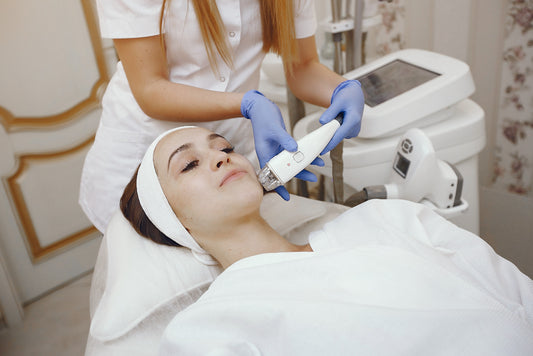Many people use microneedling to rejuvenate their skin.
Microneedling (aka collagen-induction therapy) is a popular nonsurgical procedure that penetrates your skin’s surface with fine needles and improves its appearance.
The process is well-known for creating firm skin texture and evening the skin tone simultaneously. This tried and tested treatment revives the skin with a youthful radiance, reducing the effect of hyperpigmentation.
The microneedling process involves the creation of tiny wounds in the skin to stimulate collagen and elastin production. Microneedling serves you in many different ways. It improves the appearance of the following skin imperfections:
-
Fine lines & Wrinkles
-
Uneven skin texture
-
Dull, Devitalized Skin
-
Acne Scarring
-
Sun Damage
-
Age Spots
-
Melasma
-
Scars
-
Stretch Marks
-
Enlarged pores
What is Melasma?

Melasma is one form of skin pigmentation (hyperpigmentation) that people can treat with microneedling.
This skin issue causes tan, brown, or grayish-brown patches on the forehead, cheeks, jawline, and nose bridge. It can also form on other body parts, including arms and neck.
Although melasma is not a harmful skin condition, it often leads to feelings of distress and self-consciousness, particularly when it manifests on the face.
Melasma arises from the excess pigmentation production by melanocytes, the cells responsible for creating skin color.
While not limited to this demographic, melasma predominantly affects women, especially those aged between 20 and 50.
What Causes Melasma?

Although the precise causes of melasma remain uncertain, the condition is frequently linked to hormonal changes, such as during pregnancy or due to the usage of birth control pills or hormone replacement therapy.
Additionally, excessive sun exposure plays a role in melasma development, as UV light stimulates skin cells to produce pigmentation.
People might think, why is melasma so challenging to treat?
Melasma stains the epidermis, the topmost layer of the skin, alongside the deeper layer called the dermis. Often it affects them both. The component in the epidermis typically clears with skin-lightening creams, but it's usually challenging to treat the dermal part.
Microneedling for Melasma
Fortunately, melasma is a treatable skin disorder. Thanks to microneedling!
Emerging research backs the effectiveness of microneedling in hundreds of cases across all skin tones. The study gives credit to the punctures it creates in the skin.
These channels are carefully oriented to serve as tiny portals allowing lightening skin-enhancing agents to reach deeper skin layers. But the benefits of microneedling don’t end there.
How Does Microneedling Treat Melasma?

During microneedling, a skin care professional uses tiny sterile needles to prick the skin, creating micro-injuries in the skin.
The wounds signal the body needs to repair the treatment area. The body, in turn, increases cell regeneration in the damaged area.
This helps decrease melasma’s discoloration. It also increases collagen production simultaneously, creating plump skin and a natural, even skin tone.
Microneedling benefits your skin and treats melasma because of the tiny holes it creates. The needles it uses penetrate the skin at a uniform depth.
Specialists also suggest skin-lightening creams post-treatment to penetrate the skin and enhance even coloration.
Is Microneedling Good for Melasma?
Yes, microneedling is an excellent option to treat melasma. It's a safe and natural way to force the body's healing mechanism to benefit the skin. Let's dive deeper into it!
Lasers are generally considered very effective for treating melanin. But they generate heat during the process, which can make melasma worse.
Because melasma is triggered by UV rays and heat, using a heated tool or procedure for the reduction of melasma can actually make the condition even worse.
Instead, heat-free forms of skin care are suggested to treat melasma. Mechanical microneedling is considered best for this as it does not generate heat.
Microneedling offers an effective solution to diminish the appearance of melasma, helping individuals enhance their confidence and embrace their natural beauty.
By reducing the visibility of melasma, microneedling can assist you in cultivating self-assurance, developing a positive relationship with your skin, and boosting your confidence.
Gentle Chemical peels are also a proven way to treat melasma's hyperpigmentation, but microneedling is the most popular.
Is Microneedling Right For Me?

You might be considering if microneedling is suitable for you!
Microneedling stands out among other hyperpigmentation treatments as it's safe for individuals with all skin colors without the risk of blotchiness or uneven skin coloration.
However, it's important to note that microneedling may not suit everyone. If you have highly sensitive skin, ongoing skin inflammation, a rash, acne, or an oral herpes outbreak (such as a cold sore) in the treatment area, it is advised to refrain from microneedling.
It is better to wait until your skin conditions have subsided, ensuring the microneedling procedure does not spread germs or viruses.
Interested in learning more about microneedling? Read Microneedling Vs. Chemical peels - Which one is good for you?
Reduce Melasma With Microneedling In Scottsdale
If you are seeking melasma treatment, our team of skincare experts at Scottsdale is here to assist you. Our dedicated specialists will carefully assess your skin and determine if microneedling is a suitable option for you.
Once approved for the treatment, the Med Spa At's team will craft a customized microneedling plan tailored to your specific skin needs.
To receive exceptional microneedling therapy to target your melasma concerns, please contact the Med Spa At Scottsdale or complete the online contact form to schedule an appointment.
Wrapping Up
Finally, a more effective treatment for melasma is here. Although it's a frustrating skin condition for many, there is hope in microneedling with skin-lightening creams and strict sun avoidance.
This way, you can treat melasma effectively across all skin tones. The safe series of controlled punctures enables the procedure to reach the depth of the skin where melasma takes place.
The healing mechanisms of microneedling force the surrounding skin to make new skin that hasn't been affected by the sun or hormones.
Frequently Asked Questions
Q: Is it possible to perform microneedling at home?
A: Yes. Although there are microneedling rollers available for at-home use, it's important to note that these may not be as effective and can pose additional risks. At-home products often lack proper sterilization, increasing the chances of infection. Additionally, the smaller needles used in at-home rollers prioritize user safety, but this also means that they don't penetrate as deeply and, therefore, may not provide the same level of results as professional microneedling.
Q: What is the expected timeframe for microneedling to lighten melasma?
A: Generally, it is advised to undergo three microneedling sessions with a four-week interval between each session. However, the specific duration may vary based on factors such as your skin type, desired treatment goals, and the treatment area. To get a personalized assessment and discuss your individual treatment plan, we recommend scheduling a complimentary consultation with a The Medspa At skincare specialist.
Q: What measures can I take to avoid worsening my melasma?
A: To prevent the advancement or recurrence of melasma following treatment, it is crucial to apply high-quality sunscreen on exposed skin whenever you venture outdoors. Moreover, it may be beneficial to consult with your dermatologist, doctor, or gynecologist, especially if you suspect that your melasma is influenced by your birth control pill. By addressing these factors, you can proactively manage and mitigate the worsening of melasma symptoms.



 Skin Treatments
Skin Treatments





